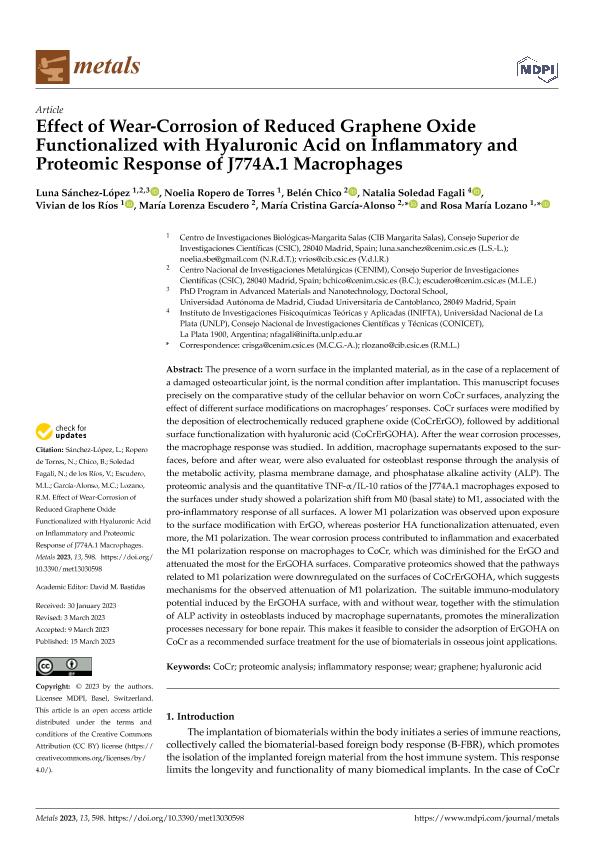Artículo
Effect of Wear-Corrosion of Reduced Graphene Oxide Functionalized with Hyaluronic Acid on Inflammatory and Proteomic Response of J774A.1 Macrophages
Sánchez López, Luna; Ropero de Torres, Noelia; Chico, Belén; Fagali, Natalia Soledad ; De los Ríos, Vivian; Escudero, María Lorenza; García-Alonso, María Cristina; Lozano Puerto, Rosa María
; De los Ríos, Vivian; Escudero, María Lorenza; García-Alonso, María Cristina; Lozano Puerto, Rosa María
 ; De los Ríos, Vivian; Escudero, María Lorenza; García-Alonso, María Cristina; Lozano Puerto, Rosa María
; De los Ríos, Vivian; Escudero, María Lorenza; García-Alonso, María Cristina; Lozano Puerto, Rosa María
Fecha de publicación:
03/2023
Editorial:
Multidisciplinary Digital Publishing Institute
Revista:
Metals
ISSN:
2075-4701
Idioma:
Inglés
Tipo de recurso:
Artículo publicado
Clasificación temática:
Resumen
The presence of a worn surface in the implanted material, as in the case of a replacement of a damaged osteoarticular joint, is the normal condition after implantation. This manuscript focuses precisely on the comparative study of the cellular behavior on worn CoCr surfaces, analyzing the effect of different surface modifications on macrophages’ responses. CoCr surfaces were modified by the deposition of electrochemically reduced graphene oxide (CoCrErGO), followed by additional surface functionalization with hyaluronic acid (CoCrErGOHA). After the wear corrosion processes, the macrophage response was studied. In addition, macrophage supernatants exposed to the surfaces, before and after wear, were also evaluated for osteoblast response through the analysis of the metabolic activity, plasma membrane damage, and phosphatase alkaline activity (ALP). The proteomic analysis and the quantitative TNF-α/IL-10 ratios of the J774A.1 macrophages exposed to the surfaces under study showed a polarization shift from M0 (basal state) to M1, associated with the pro-inflammatory response of all surfaces. A lower M1 polarization was observed upon exposure to the surface modification with ErGO, whereas posterior HA functionalization attenuated, even more, the M1 polarization. The wear corrosion process contributed to inflammation and exacerbated the M1 polarization response on macrophages to CoCr, which was diminished for the ErGO and attenuated the most for the ErGOHA surfaces. Comparative proteomics showed that the pathways related to M1 polarization were downregulated on the surfaces of CoCrErGOHA, which suggests mechanisms for the observed attenuation of M1 polarization. The suitable immuno-modulatory potential induced by the ErGOHA surface, with and without wear, together with the stimulation of ALP activity in osteoblasts induced by macrophage supernatants, promotes the mineralization processes necessary for bone repair. This makes it feasible to consider the adsorption of ErGOHA on CoCr as a recommended surface treatment for the use of biomaterials in osseous joint applications.
Palabras clave:
COCR
,
GRAPHENE
,
HYALURONIC ACID
,
INFLAMMATORY RESPONSE
,
PROTEOMIC ANALYSIS
,
WEAR
Archivos asociados
Licencia
Identificadores
Colecciones
Articulos(INIFTA)
Articulos de INST.DE INV.FISICOQUIMICAS TEORICAS Y APLIC.
Articulos de INST.DE INV.FISICOQUIMICAS TEORICAS Y APLIC.
Citación
Sánchez López, Luna; Ropero de Torres, Noelia; Chico, Belén; Fagali, Natalia Soledad; De los Ríos, Vivian; et al.; Effect of Wear-Corrosion of Reduced Graphene Oxide Functionalized with Hyaluronic Acid on Inflammatory and Proteomic Response of J774A.1 Macrophages; Multidisciplinary Digital Publishing Institute; Metals; 13; 3; 3-2023; 1-28
Compartir
Altmétricas



